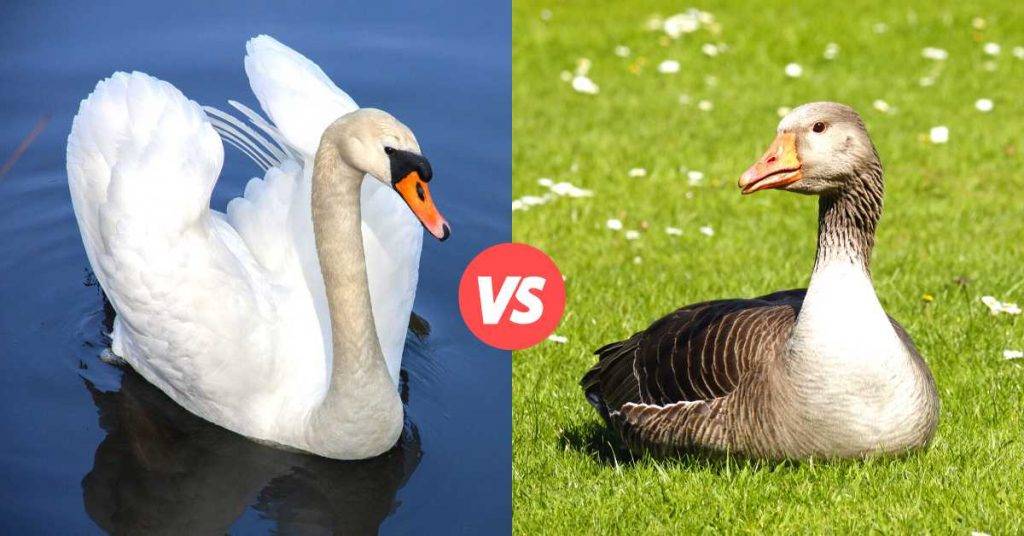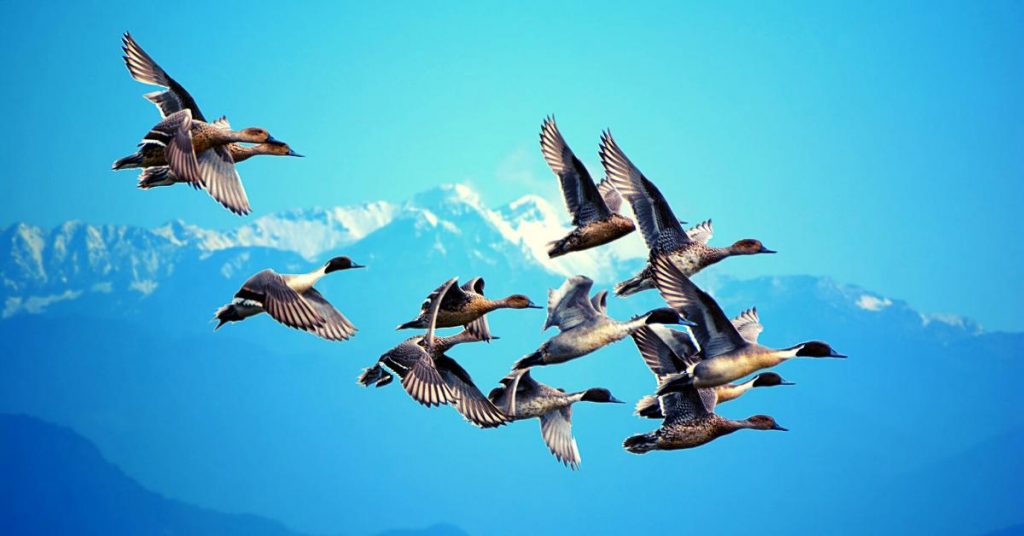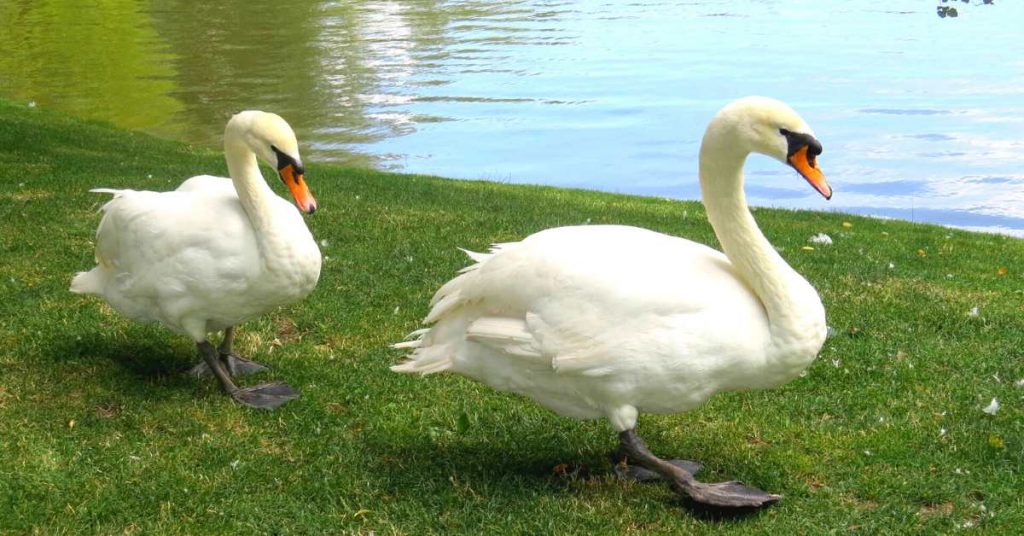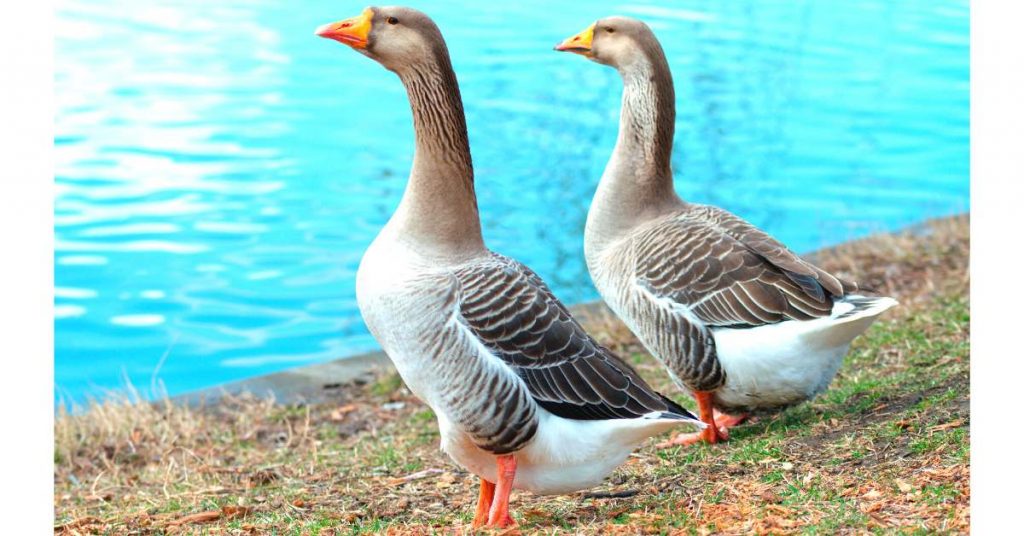What's the Difference Between Swans And Geese?

Are You Confused About The Difference Between Geese And Swans? Wonder no more! In this post, we'll take a detailed look at the differences between these two types of waterfowl. We'll consider everything from physical characteristics to their behavior and mating habits.
The physical differences between swans and geese are apparent to most people, especially those who have spent time near lakes and ponds.
However, some lesser-known differences can be harder to distinguish between the two types of birds at first glance. Read on to learn about what makes swans and geese different from each other, so you’ll be able to tell them apart the next time you come across one of these waterfowl in the wild.
So, which one do you think is better: the regal swan or the scrappy goose? Let's find out.

- Goose Vs Swan Differences at a Glance
- What is a Swan?
- Common Swans
- Swan Species
- What is a Goose?
- Goose Differences
- Common Geese
- Goose Species
- What Do They Have In Common?
- What Are Differences Between Swans And Geese?
- What Might Make A Swan Look Like A Goose?
- If A Swan Is Not A Goose, Is A Goose Not A Swan?
- How Does Canada Fit In With Swans And Geese?
- Why Are They Called Common?
- Final Thought
- Frequently Asked Questions (FAQs)
Goose Vs Swan Differences at a Glance
| Swan | Goose | |
| Kingdom | Animalia | Animalia |
| Family | Anatidae | Anatidae |
| Genus | Cygnus | Anser |
| Origin | Northern Hemisphere (US, Canada, UK) and random locations in the Southern Hemisphere | Egypt (Africa) |
| Size | 59 inches (1.5 meters) | 30 to 43 inches (0.75 to 1.1 meters) |
| Lifespan | 12 years | 10 to 24 years |
| Domesticated | No | Yes |
| Weight | 15kg | 10kg |
| Wingspan | 1 meters | 50 to 73 inches (1.27 to 1.85 meters) |
| Incubation Period | 35 to 41 days | 30 days |
| Speed | about 22 miles per hour | about 40 miles per hour |
| Eggs | 5 – 10 per year | Domestic: up to 50 eggs per year, Wild: up to 15 eggs per year |
| Egg size (long x wide) | 4.7 x 2.7 inches | 4 x 2 inches |
| Conservation Status | Least Concern | Least Concern |
| Location | Europe, North America, Australia, parts of Asia | Worldwide |
| Habitat | Lakes, ponds, slow-moving rivers | Marshes, wetlands, lakes, ponds, streams |
| Color | Typically all white (occasionally black) | White, black, grey, brown |
| Neck | Longer and thinner, visible “S” shaped curve. | Shorter and thicker, straight with no curve. |
| Behavior | Aggressive, not very social – prefer to stick with mate and young. | Social, often live in flocks. |
| Sexual Maturity | 4 to 5 years | 2 to 3 years |
| Diet | Aquatic vegetation, worms, small fish | Grass, leaves, roots, bulbs, berries, grains, small insects |
| Predators | Wolves, foxes, raccoons | Wolves, bears, eagles, foxes, raccoons |
What is a Swan?
A swan is a large aquatic bird, typically white or black, with a long neck and a curved beak. Swans are graceful creatures and are often considered symbols of beauty and love. Interestingly, the term "swan song" is derived from the belief that swans sing before they die.
Actual swans are not native to North America. While geese inhabit open lakes and wetlands, swans prefer protected ponds or marshlands. In-flight, swans hold their necks straight while geese hold their necks in an S-shape. True swans also have black bills with a yellow tip, while geese have orange or yellow bills with a black tip. Finally, actual swans sport white plumage, while most species of goose sport various shades of brown and gray.

Common Swans
There are six types of swans in existence today, but only three that you’re likely to find in North America: trumpeter, tundra, and Bewick’s. Trumpeter swans have a long curved neck, a black bill, and black legs.
They’re not very common in North America due to hunting restrictions on their wings; tundra swans are primarily found in Alaska and Canada but migrate through New England during their travels. Trumpeters are much larger than other species of a swan (the tundra is about as big as a domestic goose). Bewick’s swan is most commonly found throughout Europe, with smaller flocks finding homes across Northern Africa.
Swan Species
As per fossil records, there are six existing and thirteen extinct species of swans.
Existing swan species are
- Black-necked swan
- Black swan
- Mute swan
- Trumpeter swan
- Whooper swan
- Tundra swan
What is a Goose?
A goose is a waterfowl with a long neck, webbed feet, and a bill adapted for grazing. Geese are monogamous and mate for life. They build their nests on the ground, near water, and lay between 4 and 10 eggs. Geese can be either white or gray and have a loud honking call.

Goose Differences
To start, geese are larger birds than swans. An average goose is three to four feet long and weighs seven to eight pounds—that’s bigger than an average swan. Second, while they can both be aggressive, geese will also attack humans more often.
If a goose flies at you, it means you’re too close to its nest. Both of these are great reasons why you should never approach a nest! Lastly, geese will huddle together for warmth; about 10-15 geese can fit in a tiny area due to their large size.
Common Geese
A group of swans is called a Swan Fleet. On the other hand, a group of geese is called a Gaggle. A group of geese on the water is sometimes called a Skein, and when flying as a group, they are referred to as a Wedge. The distinction between these two birds in their joint names refers to whether they migrate or not.
Both species make long journeys, but only one can be considered migratory depending on where you live. Common geese (the non-migratory ones) tend to winter in temperate climates in North America, Europe, and Asia. In contrast, Common swans (the migratory ones) are known for winters spent in sub-tropical locations like Australia, New Zealand, and South Africa.
Goose Species
There are several existing wild and domestic species of geese, such as
- Bar-headed goose
- Emperor goose
- Ross’s goose
- Snow goose
- Greylag goose
- Swan goose
- Pink-footed goose
- Tundra bean goose, etc.
As per fossil records, there are twenty-three extinct types of geese to date. However, not all of them are true geese.
Some of these extinct birds are
- The Orinoco goose,
- The Egyptian goose,
- The South American sheldgeese,
- The prehistoric Malagasy sheldgoose,
- The blue-winged geese,
- The Cape Barren goose,
- The pygmy goose, etc.
What Do They Have In Common?
They are both waterfowl, meaning they both spend a good deal of time in the water. They also share many physical features, such as their long necks, webbed feet, and feathers.
In fact, the Latin name for the swan, Cygnus, is also the genus for geese. But that's where the similarities end. Swans have a more curved beak than geese, and their feathers are usually softer and more lustrous. Lastly, the sound that a swan makes is much more ethereal than the honking of a goose.
What Are Differences Between Swans And Geese?
Here are some key differences:
Swans have a long neck and bill, while geese have a shorter neck and bill. Swans are heavier than geese and can be more aggressive. Geese are better at flying and can swim faster.
On the other hand, Geese also have a different vocalization than swans. Swans typically make a "sneeze" sound while geese honk. Geese are shorter and have a more rounded body shape. Geese are typically brown or black, while swans are white or black.
Finally, the most distinguishing difference between the two is their voice. Swans make a soft "honk," while geese produce a loud "quack."
Size
Swans are usually larger than geese. (The average weight of a swan is 10–20 kg and the average weight of a goose is 6–9 kg.)
Colors
Swans are usually white or gray with black-and-white geometric patterns on their heads. Geese generally are brown with black and white geometric patterns on their heads.
Distribution
Swans live in temperate climates around the world. Geese are native to most of North America, Europe, and Asia.
Behavior
The swan is an active bird that feeds in lakes and rivers. They are found in most parts of the world except Antarctica. The goose is a land bird, and they live in grasslands, marshes, taiga forests, and wetlands.
Shape
Geese have a more streamlined shape than swans.
Legs
Swans have long legs, while geese have short legs.
Neck
Swans have a longer neck than geese.
Bill
Swans have a longer, more curved bill than geese.
Flight
Swans fly with their necks outstretched, while geese keep their necks tucked in when flying. Swans have a long neck and head. They are more likely to fly in flocks than geese.
Nesting
Swans are primarily monogamous, but some species of swans form pairs that share the nesting duties.
Diet
Geese and swans are herbivores and eat grass, fruits, and berries. Swans eat aquatic plants, while geese eat grasses and sedges.
Habitat
Swans live near water, while geese prefer open country.
What Might Make A Swan Look Like A Goose?
Swans and geese are two types of birds that are often confused, but there are some critical differences between them. Swans have long necks and are usually white or black, while geese have short necks and are gray or white. Geese are also larger than swans.
Another way to tell them apart is by the shape of their beaks: swans have a curved beak while geese have a flat beak. Finally, the sound they make is also different: geese honk while swans quack.
If A Swan Is Not A Goose, Is A Goose Not A Swan?
People have this common question, but it's not that straightforward. The answer is yes and no. Technically speaking, all geese are swans, but not all swans are geese. Are they confused yet?
Let us explain.
Geese are a type of swan, but not all swans are geese. Got it? Good. Swans are a more general term that includes geese and other types of swans, such as the mute swan.
So a goose is a type of swan, but not all types of swans are geese. Make sense? If not, don't worry—remember that all geese are swans, but not all swans are geese.
How Does Canada Fit In With Swans And Geese?
Swan and geese populations are on the rise in Canada, but there are still some crucial distinctions between the two types of birds. Geese tend to be far more populous and can be found in various habitats, while swans are more likely to be seen in protected areas or near bodies of water.
Swans are also considerably larger than geese, and their necks are typically much longer. Canada is a key stopover area for both swans and geese during their migrations, so it's essential to be familiar with the differences between these two types of birds.
Why Are They Called Common?
There are more geese than swans in Europe and Asia, so it makes sense that they’re called common swans there. In North America and Australia, however, geese are much more numerous.
So what gives?
Well, we’re not entirely sure—but there are a few theories as to why we call our geese common here and not just geese. The first is that our native birds don’t have cultural significance in other parts of the world.
Final Thought
Although swans and geese may look very similar, there are several key differences between the two. Geese are typically smaller in size and have shorter necks than swans, and they also have a different beak shape. Swans are generally considered more graceful creatures than geese, and they are also known to be more aggressive in defending their territory. If you're ever unsure about whether a bird is a swan or a goose, it's best to err on the side of caution and assume it's a goose.
Frequently Asked Questions (FAQs)
Q: Is swan goose a goose or a swan?
Ans: The swan goose (Anser cygnoides) is a goose. But not a swan.
Q: What is snow goose?
Ans: The snow goose (Anser caerulescens) is a goose species from Anser genus (white and gray goose) native to North America.
Q: Is there any goose and swan hybrid?
Ans: Goose and swan have no natural breeding. However, Swooses are the captive breeding swans and goose.
Q: Can anybody own a swan in the United States?
Ans: Yes. But as an aggressive species, only the mute swans (Cygnus olor) have restrictions in the states of California, New York, Maryland, and Oregon.
Q: Are Cape Barren goose, New Zealand goose, pygmy goose, sheldgoose, spur-winged goose true geese?
Ans: No. Sheldgoose or shelduck, New-Zealand goose, Cape Barren goose, pygmy goose, spur-winged goose are not true geese.

Recommendation